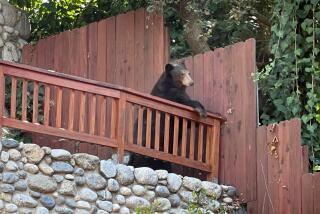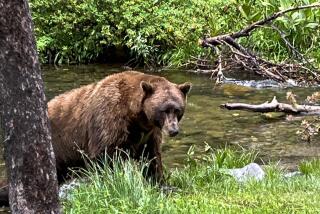Asian Market for Body Parts Spurs Bear Poaching in Pacific Northwest
- Share via
SALEM, Ore. — Wayne Smith is a plainspoken man who can’t read or write. He’s not your typical convert to the Asian medicinal secrets brewing in the belly of a black bear.
The bear’s jiggling, apple-green gallbladder contains bile that is a highly valued drug in the Orient and is the only thing Smith has found that can soothe his throbbing headaches.
“It’s bitter as hell. You’ve got to pretty well grit your teeth to take it,” said the 65-year-old retiree. “But I guarantee, it does make you feel better.”
Demand for bear parts in Asia and in Chinatowns around the world has fueled a bear-poaching industry that has begun to tap the West.
Even Smith himself was arrested recently on charges that he was part of a poaching ring that killed 28 black bears, gutted them for their gallbladders and left their carcasses for the vultures. In some cases, they also allegedly chopped off the bear’s saucer-sized, sharp-clawed paws.
In states such as Oregon, where the sale of bear parts is illegal, authorities are using racketeering laws to ratchet up the penalties. Where a poaching arrest once brought no more than a year behind bars, the accused ringleader in the latest bust could get up to 20 years in prison if convicted.
Officials hope stiffer penalties will take a bite out of poaching’s profit margins.
In Asia, a properly dried gallbladder can fetch hundreds, even thousands, of dollars for its soothing effects on fevers and liver and blood diseases. And a steaming bowl of bear paw soup serves up for more than $100 in posh restaurants. Some paws even end up as ashtrays.
“People are pretty innovative in what they do with animal parts,” said Lt. Steve Lane of the Oregon State Police fish and wildlife division.
Lane said it’s nearly impossible to estimate just how much poaching goes on, but that there’s a local market in the Northwest as well as abroad.
According to Smith, an Asian dealer in Eugene, Ore., ships gallbladders overseas from his dry- cleaning business. He buys them from local poachers.
“One guy, I’m pretty sure he sold $3,600 worth of gallbladders. He liked to brag to me,” Smith said.
Internationally, it’s a $2-billion industry, according to Bear Watch, a British Columbia-based conservation group.
Officials say that many of the poached bear parts stay stateside in Chinese pharmacies.
“You could go into just about any apothecary and find animal parts that under federal guidelines could be illegal. But it’s hard to tell. Some of that is dealt behind the counter,” Lane said.
In a study released in January by World Conservation and the World Wildlife Fund, nearly half of 110 shops surveyed in seven North American Chinatowns, including those in Vancouver and Seattle, sold illegal animal products--not only bear, but tiger, rhino, leopard and musk deer.
“It’s a conservation issue that needs to be addressed. But bear populations are doing well despite the trade. At this point, it’s not driving bears to extinction,” said Craig Hoover of Traffic North America, a division of the World Wildlife Fund.
The number of black bears poached for their gallbladders and paws approaches 40,000 in North America, said Anthony Marr of the Vancouver-based Western Canada Wilderness Committee.
He said that it has been on the increase since the late 1980s and probably will skyrocket over the next two decades as China and the rest of Asia develop.
Practitioners of traditional Chinese medicine say that such concerns are overblown.
“Nobody really uses gallbladder. It’s just like the exotic old rhino horn. Somebody gets caught once and it makes the news. It really has nothing to do with our business,” said Jim Alan, the dispensary supervisor at the Oregon College of Oriental Medicine.
Activists say that undermining demand is the best long-term solution to poaching. Chinese Canadian Anthony Marr educates Vancouver’s Chinese community in alternatives to herbal medicine’s endangered ingredients.
But old habits are hard to break.
“In a laboratory, you can replicate the gall bile exactly. It’s exactly the same thing. But they don’t want it because it isn’t made in a bear,” said Pete Nylander, an agent for the U.S. Fish and Wildlife Service.
Unlike rhinoceros horn, which has only mythical powers as an aphrodisiac, bear bile actually packs a medicinal punch. It contains a chemical called tauro-ursodesoxycholic acid that is particular to bears and effectively treats cardiovascular and liver diseases and fevers.
Gallbladders are slimy bright green organs nestled under the bear’s liver. The bile-filled sacks are wobbly, like a water balloon, after they are cut out.
When the gallbladders are dried to shriveled brown sacks, the acids inside them crystallize. People then scoop out the powder and sprinkle it in their tea, juice and even whiskey.
Smith said his preference is to just slug it back with orange juice from a shot glass.
But he said his taste for the tincture doesn’t make him a poacher--all his bear gallbladders come from his friends as gifts.
“I ain’t going to rat on them because if they catch me in the woods, they’ll shoot.”
More to Read
Sign up for Essential California
The most important California stories and recommendations in your inbox every morning.
You may occasionally receive promotional content from the Los Angeles Times.













